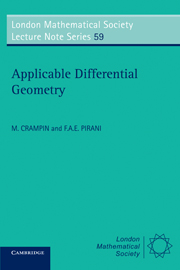Book contents
- Frontmatter
- Contents
- Preface
- 0 The background: vector calculus
- 1 Affine spaces
- 2 Curves, functions and derivatives
- 3 Vector fields and flows
- 4 Volumes and subspaces: exterior algebra
- 5 Calculus of forms
- 6 Frobenius's theorem
- 7 Metrics on affine spaces
- 8 Isometries
- 9 Geometry of surfaces
- 10 Manifolds
- 11 Connections
- 12 Lie groups
- 13 The tangent and cotangent bundles
- 14 Fibre bundles
- 15 Connections revisited
- Bibliography
- Index
7 - Metrics on affine spaces
Published online by Cambridge University Press: 05 August 2012
- Frontmatter
- Contents
- Preface
- 0 The background: vector calculus
- 1 Affine spaces
- 2 Curves, functions and derivatives
- 3 Vector fields and flows
- 4 Volumes and subspaces: exterior algebra
- 5 Calculus of forms
- 6 Frobenius's theorem
- 7 Metrics on affine spaces
- 8 Isometries
- 9 Geometry of surfaces
- 10 Manifolds
- 11 Connections
- 12 Lie groups
- 13 The tangent and cotangent bundles
- 14 Fibre bundles
- 15 Connections revisited
- Bibliography
- Index
Summary
The ordinary scalar product of vectors which one encounters in elementary mechanics and geometry may be generalised to affine spaces of dimension other than 3. In elementary Euclidean geometry one is concerned mostly with the use of the scalar product to measure lengths of, and angles between, displacements; in mechanics one is also concerned with magnitudes of, and angles between, velocity vectors. In either case the scalar product comes from an operation in a vector space V, which may be transferred to an affine space A modelled on it. The realisation of V as tangent space to A at each point generalises to manifolds, as will be explained in Chapters 9 and, especially, 10, but the realisation as space of displacements does not. We shall therefore give preference to the tangent space realisation in this chapter.
The structure on A determined in this way by a scalar product on V is usually called a metric. It is unfortunate, but now irremediable, that the word is used in a different sense in topology. In the case of Euclidean space the two meanings are closely related; however, as well as the generalisation to arbitrary dimension, we shall also consider the generalisation of the concept of a scalar product in a different direction, which includes the space-time of special relativity, and in this case the relation between the two meanings of the word metric is not close.
- Type
- Chapter
- Information
- Applicable Differential Geometry , pp. 164 - 187Publisher: Cambridge University PressPrint publication year: 1987

